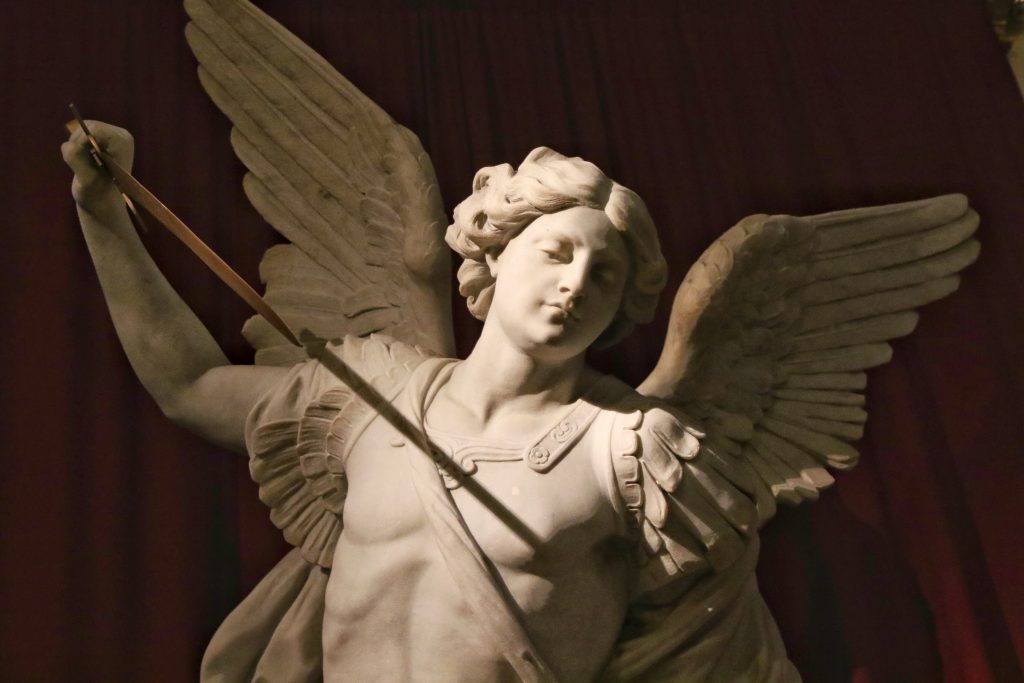At his September 26 General Audience, Pope Francis spoke of the “spiritual turbulence” the Church is experiencing right now. Among the remedies he prescribed was the traditional Prayer to St. Michael the Archangel.
Michael’s mission, he noted, is “to protect the Church from the devil, who always aims to divide us from God and among ourselves.”
A large number of U.S. dioceses — from Portland, Oregon, to Bridgeport, Connecticut — followed the Holy Father’s lead and required or requested that priests recite the prayer with their congregations at the end of all Masses.
It’s not an innovation; it’s a restoration. From 1886 until the mid-1960s, the Prayer to St. Michael was included among a number of prayers offered at the end of every Low Mass.
They were called the Leonine Prayers because they were decreed, at least in their final form, by Pope Leo XIII.
He and his predecessor, Blessed Pius IX, added the prayers in order to call down heaven’s help for the resolution of worsening divisions in the Church and in society — the divisions that made the pope a “prisoner of the Vatican” and diminished his peacemaking influence as Europe hurtled toward a series of bloody wars.
The Prayer to St. Michael was Leo’s particular contribution. The story is commonly told that he composed the prayer immediately after seeing a vision of the evils that would be unloosed in the coming century.
There is no contemporary documentation or eyewitness reports for Leo’s vision, and he made no public mention of it. The story first appeared in print in the 1930s, long after Leo’s death in 1903, and was almost immediately disputed by some historians.
But it’s undeniable that Michael, as the angelic defender of the Church, became a preoccupation for Leo during the years the vision allegedly occurred. He composed that prayer and mandated its use at Mass. He promulgated a rite of exorcism in which Michael figures prominently. And he published other mid-sized prayers to the archangel as well.
In doing so, he drew deeply from the most ancient sources of biblical religion. Michael is mentioned by name in three books of the Bible. In the Old Testament Book of Daniel he appears three times.
He is identified as the heavenly guardian of God’s Chosen People, who receive assurance that he will defend them in the tribulations of the end times (see Daniel 10:12-14, 10:21, and 12:1).
In the New Testament, Michael appears as the leader of God’s forces in the great cosmic war against Satan: “Now war arose in heaven, Michael and his angels fighting against the dragon” (Revelation 12:7). In the Letter of Jude (1:9) he makes a cameo appearance, defending the dead body of Moses against the devil.
In early rabbinic Judaism Michael was invoked as Israel’s great defender. The ancient rabbis believed that he had been involved in the history of the Chosen People since the time of Abraham’s calling.
The Jewish sect that produced the Dead Sea Scrolls (around the first century) expected Michael to appear as their leader during an impending world war.
The early Christians eagerly took up the devotion to Michael and looked to him as their defender in times of persecution. Soon after the Faith was legalized in 313 A.D., the Emperor Constantine raised a great church in honor of the archangel in his capital city.
Devotion appeared in varied forms. There were many other churches named for Michael. He appears in Christian art and texts that have survived from the early centuries.
In 2005, archaeologists in Sudan unearthed a unique expression of love for Michael — a tattoo of his name preserved on the mummified remains of a young woman who died in the seventh or eighth century.
Pope Francis has asked the Church to pray the prayer, and so Catholics will simply do what followers of biblical religion have done in every age — call to Michael to “defend us … be our protection.”
It’s good advice, time-tested by millennia.

